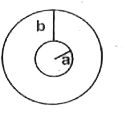The magnetic flux through a coil perpendicular to its plane is varying according to the relation ϕB=(5t3+4t2+2t−5) weber. Calculate the induced current through the coil at t = 2 second. The resistance of the coil is 5Ω
To solve the problem of finding the induced current through the coil at t=2 seconds, we will follow these steps:
Step 1: Write down the expression for magnetic flux
The magnetic flux ϕB through the coil is given by:
ϕB=5t3+4t2+2t−5(in Weber)
Step 2: Calculate the induced EMF
The induced EMF (E) can be calculated using Faraday's law of electromagnetic induction, which states:
E=−dϕBdt
We will differentiate the expression for ϕB with respect to time t.
Step 3: Differentiate the magnetic flux
Differentiating ϕB:
dϕBdt=ddt(5t3+4t2+2t−5)
Calculating the derivative:
dϕBdt=15t2+8t+2
Step 4: Substitute t=2 seconds into the derivative
Now, we will substitute t=2 seconds into the derivative to find the induced EMF:
E=15(22)+8(2)+2
Calculating this:
E=15(4)+16+2=60+16+2=78(in volts)
Step 5: Calculate the induced current
Using Ohm's law, the induced current I can be calculated as:
I=ER
where R is the resistance of the coil, given as 5Ω.
Substituting the values:
I=785=15.6(in amperes)
Final Answer
The induced current through the coil at t=2 seconds is:
15.6A
---
The magnetic flux ϕB through the coil is given by:
ϕB=5t3+4t2+2t−5(in Weber)
The induced EMF (E) can be calculated using Faraday's law of electromagnetic induction, which states:
E=−dϕBdt
We will differentiate the expression for ϕB with respect to time t.
Differentiating ϕB:
dϕBdt=ddt(5t3+4t2+2t−5)
Calculating the derivative:
dϕBdt=15t2+8t+2
Now, we will substitute t=2 seconds into the derivative to find the induced EMF:
E=15(22)+8(2)+2
Calculating this:
E=15(4)+16+2=60+16+2=78(in volts)
Using Ohm's law, the induced current I can be calculated as:
I=ER
where R is the resistance of the coil, given as 5Ω.
I=785=15.6(in amperes)
The induced current through the coil at t=2 seconds is:
15.6A
Topper's Solved these Questions
- ELECTROMAGNETIC INDUCTIONBook:AAKASH SERIESChapter:ELECTROMAGNETIC INDUCTIONExercise:EXERCISE-IA
Explore 58 Videos
- ELECTROMAGNETIC INDUCTIONBook:AAKASH SERIESChapter:ELECTROMAGNETIC INDUCTIONExercise:EXERCISE-IB
Explore 18 Videos
- ELECTRIC FIELD AND POTENTIALBook:AAKASH SERIESChapter:ELECTRIC FIELD AND POTENTIALExercise:PROBLEMS (LEVEL-II)
Explore 26 Videos
- ELECTROMAGNETIC WAVESBook:AAKASH SERIESChapter:ELECTROMAGNETIC WAVESExercise:EXERCISE -II
Explore 22 Videos
Similar Questions
Knowledge Check
The magnetic flux through a coil perpendicluar to its plane and directed into paper is varying according to the relation ϕ=(2t2+4t+6)mWb. The emf induced in the loop at t=4 s is
A0.12 VB2.4 VC0.02 VD1.2 VThe magnetic flux (ϕ) in a closed circuit of resistance 20Ω varies with time (t) according to the equation ϕ=7t2−4t where ϕ is in weber and t is in seconds. The magnitude of the induced current at t =0.25s is
A25mAB0.025mAC47 mAD175 mAA particle moves in x-y plane according to the equations x=4t2+5t+16andy=5t where x, y are in metre and t is in second. The acceleration of the particle is
A8ms−2B12ms−2C14ms−2D16ms−2
The magnetic flux ϕ (in weber ) in a closed circuit of resistance 10Ω varies with time t (in secnod) according to equation ϕ=6t2−5T+1. The magnitude of induced current at t=0.25 s is
View SolutionThe magnetic flux linked with a coil (in Wb) is given by the equation ϕ=5t2+3t+16 . The magnetic of induced emf in the coil at fourth second will be
View SolutionThe magnetic flux through a coil varies with time as ϕ=5t2−6t+9. The ratio of E.M.F. at t=0s to t=0.5s will be
View SolutionThe magnetic flux through a coil varies with time as ϕ=5t2+6t+9 The ratio of emf at t = 3 s to t = 0 s will be
View SolutionFlux ϕ (in weber) in a closed circuit of resistance5 omega varies with time (in second) according to equation ϕ=3t2−5t+2. The magnitude of average induced current between0 to 2s is
View Solution


